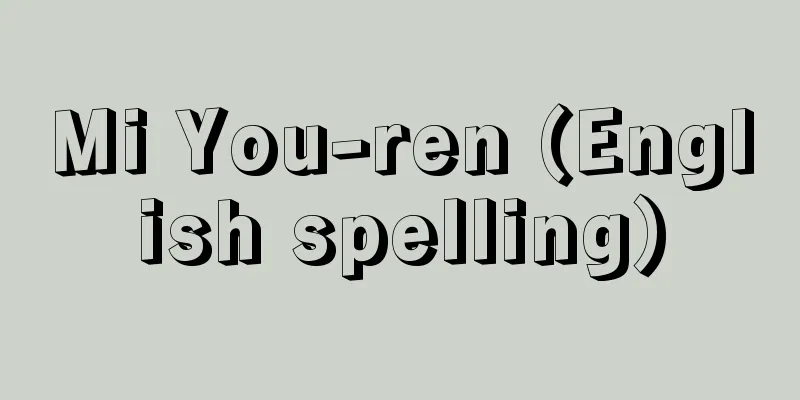Corporal punishment

|
According to a 1948 (Showa 23) notice from the Attorney General of the Ministry of Justice entitled "Degrees of Disciplinary Actions," corporal punishment is defined as "violation of the body, or discipline that inflicts physical pain on the punished individual." In English, the terms "physical punishment" and "corporal punishment" are also used. Corporal punishment is clearly prohibited in Japanese schools under the School Education Act. Teachers who use corporal punishment are subject to disciplinary action and are often held criminally liable. [Akira Ninomiya] History of corporal punishmentIn the past, in European countries, it was said that "going to school" and "being whipped" were synonymous. Corporal punishment was often carried out using harsh methods such as canes, whips, and slaps, and usually resulted in bruises and bleeding, and some even led to death. In the history of European education, there were almost no voices against corporal punishment, and even Pestalozzi and Rousseau condoned it. The ideological background of corporal punishment is the idea of the Old Testament and the idea of original sin represented by Calvinists (the idea that humans who disobey God's laws have fallen into depravity and come under the control of the devil). Under this idea, corporal punishment has been justified as a means of correcting children. Corporal punishment was also widely practiced in Japan. In this way, corporal punishment is a double-edged sword that has been widely used throughout the history of the world as an important and effective means of correcting and disciplining children. [Akira Ninomiya] Corporal punishment around the worldThe United Kingdom and its former colonies have inherited this tradition of corporal punishment based on Christian thought, and corporal punishment is still permitted today. Corporal punishment is also permitted in many southern states of the United States, including Texas. The most common methods of corporal punishment are hitting students on the buttocks or hands with a whip or paddle. In contrast, corporal punishment is prohibited in schools in continental European countries such as France, Germany, Spain, and Portugal, in their colonies in Latin America, and in northern states such as New Jersey in the United States. Corporal punishment has been practiced in these countries for a long time, but with the rise of human rights ideas and humanistic educational ideas since the second half of the 19th century, corporal punishment was gradually banned, and remains so to this day. Corporal punishment is also prohibited in Islamic countries, Israel, China, and other countries. [Akira Ninomiya] Corporal punishment in JapanIn Japan, corporal punishment was banned in the Education Order (Article 46) of 1879 (Meiji 12), when regulations banning corporal punishment were still rare around the world, and since then, corporal punishment in education has been consistently prohibited, including during World War I and World War II, to the present day. The Elementary School Order (Article 47) of 1900 (Meiji 33) prohibited corporal punishment, but included provisions allowing disciplinary action, and a similar view is still carried over to the current School Education Act (Article 11). Following the 1948 notice entitled "Levels of Disciplinary Punishment," the Ministry of Justice issued a notice in 1949 entitled "Teachers' Guidelines Regarding the Prohibition of Corporal Punishment of Students," which prohibited corporal punishment such as not allowing students to go to the toilet or barring late students from the classroom, but permitted disciplinary measures such as leaving students at school after school or increasing the number of times they had to clean. Since the 1960s, with the increase in school violence, there has been lively discussion about corporal punishment as a "whip of love" or "love for education" by teachers, but in April 1981, the Tokyo High Court reversed a ruling on corporal punishment, stating that "the use of minor force that is socially acceptable is within the scope of the disciplinary powers granted to teachers, and does not constitute corporal punishment." Later, in 1995, the Tokyo District Court ruled again that corporal punishment is prohibited, and in January 2000, the Kobe District Court recognized a connection between corporal punishment and student suicides, ruling that the city was responsible for "violating the duty to take safety precautions." Regarding the number of cases of corporal punishment, according to a survey by the Ministry of Education (now the Ministry of Education, Culture, Sports, Science and Technology), in 1998 (Heisei 10), investigations were conducted into 1,010 cases of possible corporal punishment, and 833 schools were actually involved in incidents of corporal punishment. [Akira Ninomiya] Future challengesAs seen above, views on corporal punishment vary, reflecting each country's view of humanity and education, and the ideology of the times. Even today, there are many differences of opinion regarding the pros and cons of corporal punishment (value judgments), its educational effectiveness (student guidance theory), and the extent to which corporal punishment is disciplinary and the extent to which it is corporal punishment (definition and standards). Furthermore, there are differences of opinion regarding the relationship between corporal punishment and the "discipline" discussed by the Ministry of Education, Culture, Sports, Science and Technology in the context of home education, and whether corporal punishment falls under the category of "physical or mental violence" mentioned in the Convention on the Rights of the Child (Article 19). It can be said that education and corporal punishment are always inseparable, including the current situation in which corporal punishment by teachers and parents continues to persist. [Akira Ninomiya] "The Birth of the Prison" by Michel Foucault, translated by Tamura Hajime (1977, Shinchosha)" ▽ "Corporal Punishment" by Okihara Yutaka (1980, Daiichi Hoki Publishing)" ▽ "A Social History of Corporal Punishment" by Emori Ichiro (1989, Shinyosha)" ▽ "Legislation and Reality of Discipline and Corporal Punishment" edited by Maki Masana, Imabashi Morikatsu, Hayashi Ryoshu, and Terasaki Hiroaki (1992, Gakuyo Shobo)" ▽ "Sakamoto Hideo, A Study of Corporal Punishment (1995, San'ichi Shobo)" ▽ "Life Guidance and Discipline/Corporal Punishment" edited by Fujita Masashi (1996, Tokyo Horei Publishing) [References] | | | | |Source: Shogakukan Encyclopedia Nipponica About Encyclopedia Nipponica Information | Legend |
|
体罰とは、1948年(昭和23)の法務庁法務長官通達「懲戒の程度」によると、「身体に対する侵害、被罰者に肉体的苦痛を与えるような懲戒」のこととされている。英語でも「身体的懲戒」にあたるphysical punishmentあるいはcorporal punishmentの用語が用いられる。日本の学校では体罰は学校教育法で明確に禁止されている。体罰を行使する教師は懲戒の対象となり、かつ刑法上の責任を問われることが少なくない。 [二宮 皓] 体罰の歴史かつてヨーロッパの国々では、「学校へ行くこと」と「むち打たれること」は同義であるといわれていた。体罰の方法は杖(つえ)やむち、平手打ちなど過酷なものが多く、打撲傷や出血を伴うのが普通であり、なかには死に至るものもあった。ヨーロッパの教育の歴史において、体罰に反対する声はほとんどなく、ペスタロッチやルソーなどでさえも体罰を容認していた。体罰の思想的背景として、『旧約聖書』の思想やカルビニストたちに代表される原罪思想(神の掟(おきて)に背いた人間は堕落し、悪魔の支配を受けるようになったという思想)がある。この思想の下に、子供の矯正の手段として体罰などが正当化されてきたのである。また日本でも、一般的には体罰が広く行われていた。このように、体罰とは世界の歴史のなかで、子供を矯正し、しつける、重要で有効な手段として広く用いられてきた両刃(もろは)の剣である。 [二宮 皓] 世界の体罰こうしたキリスト教的思想背景をもつ体罰の伝統を受け継ぎ、現在でも体罰が容認されているのが、イギリスとその旧植民地諸国である。またテキサス州をはじめとするアメリカ南部の多くの州でも、体罰は認められている。体罰の方法としては、一般にむちやパドルpaddle(体罰板)で生徒の尻(しり)や手を打つ方法がとられている。 これに対してフランス、ドイツ、スペイン、ポルトガルなどのヨーロッパ大陸諸国、その植民地であった中南米諸国の学校、アメリカでもニュージャージー州をはじめとする北部の州では体罰が禁止されている。これらの諸国でも体罰は古くから行われていたが、19世紀後半以来の人権思想やヒューマニズム的教育思想の高まりに伴い、しだいに体罰を禁止し、今日に至っている。そのほか、イスラム教の諸国、イスラエル、中国などでも体罰は禁止されている。 [二宮 皓] 日本の体罰日本では、世界的にまだ体罰禁止規定の珍しかった、1879年(明治12)の教育令(第46条)により禁止されて以来、第一次、第二次世界大戦中を含め、現在まで一貫して教育上の体罰は禁じられている。1900年(明治33)の小学校令(第47条)では、体罰を禁止する一方、懲戒を認める記述が規定され、現行の学校教育法(第11条)でも同様な見解が引き継がれている。 1948年(昭和23)の通達「懲戒の程度」に続き、法務庁は49年に通達「生徒に対する体罰禁止に関する教師の心得」で、用便に行かせないこと、遅刻した生徒を教室に入れないことなどを体罰として禁じ、放課後残すこと、掃除当番などの回数を多くすることなどは懲戒として認められるとした。 1960年代以降、校内暴力の増加に伴って、教師の「愛のむち」「教育愛」としての体罰をめぐる議論が盛んであったが、1981年4月の東京高裁での体罰に関する逆転判決において「社会通念上許される程度の軽微な力の行使は、教師に認められている懲戒権の範囲内の行為であり、体罰には該当しない」という見解が示された。その後、95年(平成7)の東京地裁の判決では、体罰が禁止されていることが改めて確認され、2000年(平成12)1月の神戸地裁では体罰と生徒の自殺の関連を認め、「安全配慮義務違反」として市の責任を認める判決を下した。 なお、体罰の発生件数については、文部省(現文部科学省)の調べによると、1998年(平成10)に体罰の可能性があるとして事実関係の調査が行われた件数は1010件、実際に体罰事件が発生した学校は833校となっている。 [二宮 皓] 今後の課題以上のように体罰に関する見方は、それぞれの国の人間観や教育観、時代の思想を反映してさまざまである。そして現在でも体罰をめぐる是非(価値判断)、教育上の効果(生徒指導論)、どこまでが懲戒でどこからが体罰か(体罰の定義と基準)など、多くの意見の相違がある。また、文部科学省の家庭教育に関する文脈で語られる「しつけ」との関係や、子どもの権利条約(第19条)で言及されている「身体的若(も)しくは精神的な暴力」に該当するか否かなど、いっこうになくならない教師や親による体罰の現状も含め、教育と体罰は常に切り離せないことがらであるといえる。 [二宮 皓] 『ミシェル・フーコー著、田村俶訳『監獄の誕生』(1977・新潮社)』▽『沖原豊著『体罰』(1980・第一法規出版)』▽『江森一郎著『体罰の社会史』(1989・新曜社)』▽『牧柾名・今橋盛勝・林量俶・寺崎弘昭編著『懲戒・体罰の法制と実態』(1992・学陽書房)』▽『坂本秀夫著『体罰の研究』(1995・三一書房)』▽『藤田昌士編『生活の指導と懲戒・体罰』(1996・東京法令出版)』 [参照項目] | | | | |出典 小学館 日本大百科全書(ニッポニカ)日本大百科全書(ニッポニカ)について 情報 | 凡例 |
<<: Postscript - Great Explosion
>>: Large cart - Daihachiguruma
Recommend
The Emi Oshikatsu Rebellion - The Emi Oshikatsu Rebellion
A rebellion started by Emi no Oshikatsu (Fujiwara ...
Euphrates [river] - Euphrates
A large river in Western Asia. It originates near ...
Pachyphytum
… [associated species] There are 40 species of Du...
Five principles for peace
The principles were first internationally articula...
Neighborhood relations (English spelling) Nachbarverhältnis German
Legal relations between adjacent real estate owne...
Reza'iye (English spelling)
…The city has a beautiful main mosque built durin...
Azalomycin F - Azalomycin F
…These act on tinea fungi, Candida, etc., but are...
Kagisama - Kagisama
...The fish-shaped crossbars were especially call...
Asazuke - Asazuke
〘 noun 〙 Pickling for a short period of time. Also...
Yin and Yang
〘Noun〙① Two types of energy that exist between hea...
Haile Selassie
1892‐1975 Emperor of Ethiopia. Reigned 1930-1974. ...
Entertainment expenses
Generally, these are expenses incurred when a com...
Dominant - Yuusei (English spelling)
A trait or gene that appears as a trait in an ind...
Cost of living index - cost of living index
A type of price index calculated based on the cost...
Big Bag and Small Bag - Big Bag and Small Bag
… In Japan, Andersen's story was translated b...









